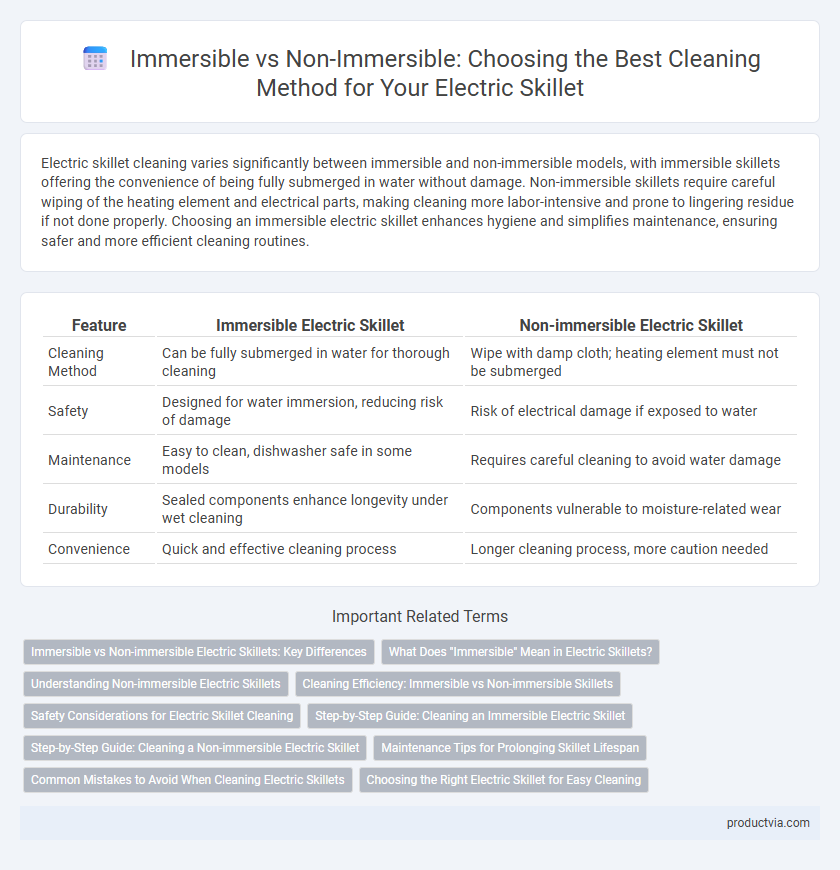Electric skillet cleaning varies significantly between immersible and non-immersible models, with immersible skillets offering the convenience of being fully submerged in water without damage. Non-immersible skillets require careful wiping of the heating element and electrical parts, making cleaning more labor-intensive and prone to lingering residue if not done properly. Choosing an immersible electric skillet enhances hygiene and simplifies maintenance, ensuring safer and more efficient cleaning routines.
Table of Comparison
| Feature | Immersible Electric Skillet | Non-immersible Electric Skillet |
|---|---|---|
| Cleaning Method | Can be fully submerged in water for thorough cleaning | Wipe with damp cloth; heating element must not be submerged |
| Safety | Designed for water immersion, reducing risk of damage | Risk of electrical damage if exposed to water |
| Maintenance | Easy to clean, dishwasher safe in some models | Requires careful cleaning to avoid water damage |
| Durability | Sealed components enhance longevity under wet cleaning | Components vulnerable to moisture-related wear |
| Convenience | Quick and effective cleaning process | Longer cleaning process, more caution needed |
Immersible vs Non-immersible Electric Skillets: Key Differences
Immersible electric skillets feature waterproof designs allowing safe submersion in water for thorough cleaning, while non-immersible skillets require surface cleaning to protect electrical components. The key difference lies in convenience and maintenance, as immersible skillets simplify post-use cleanup by permitting full immersion, reducing manual scrubbing effort. Choosing between these types depends on user preference for ease of cleaning versus design and price considerations.
What Does "Immersible" Mean in Electric Skillets?
Immersible electric skillets are designed to be fully submersed in water for easy and thorough cleaning, ensuring electrical components are sealed and waterproof. Non-immersible skillets require careful cleaning by wiping or partial rinsing since their electrical parts cannot withstand full water exposure. Choosing an immersible skillet simplifies maintenance and prolongs the appliance's lifespan by preventing water damage during washing.
Understanding Non-immersible Electric Skillets
Non-immersible electric skillets require careful cleaning methods to avoid damaging electrical components, as submerging them in water can cause short circuits and corrosion. These skillets typically have a heating element integrated with the cooking surface, making it essential to clean with a damp cloth and mild detergent without fully immersing. Understanding the manufacturer's care instructions ensures safe maintenance and prolongs the lifespan of non-immersible electric skillets.
Cleaning Efficiency: Immersible vs Non-immersible Skillets
Immersible electric skillets offer superior cleaning efficiency due to their waterproof design, allowing users to submerge the entire unit for thorough washing, which eliminates grease and food residues more effectively. Non-immersible skillets require careful surface cleaning and cannot be fully submerged, often leaving behind stubborn stains and requiring more effort to maintain cleanliness. Choosing an immersible skillet significantly reduces cleaning time and enhances hygiene by facilitating complete, convenient cleaning processes.
Safety Considerations for Electric Skillet Cleaning
Immersible electric skillets feature waterproof designs that allow safe submersion in water for thorough cleaning, reducing the risk of electrical damage and injury. Non-immersible skillets require careful cleaning to avoid water contact with electrical components, emphasizing the need to unplug the device and use damp cloths instead of immersing it. Prioritizing these safety considerations ensures effective cleaning without compromising the skillet's functionality or user safety.
Step-by-Step Guide: Cleaning an Immersible Electric Skillet
To clean an immersible electric skillet, first unplug the appliance and ensure it has completely cooled down. Submerge the skillet body in warm, soapy water, using a soft sponge to gently scrub the cooking surface and exterior, avoiding the electrical cord. Rinse thoroughly with clean water and dry with a microfiber cloth before reassembling and storing.
Step-by-Step Guide: Cleaning a Non-immersible Electric Skillet
To clean a non-immersible electric skillet, unplug the appliance and allow it to cool completely before starting. Use a damp cloth with mild dish soap to wipe down the cooking surface and exterior, avoiding moisture near electrical components. For stubborn residue, apply a paste of baking soda and water, gently scrubbing with a soft sponge, then wipe clean with a damp cloth and dry thoroughly.
Maintenance Tips for Prolonging Skillet Lifespan
Immersible electric skillets allow full submersion in water, making thorough cleaning easier and reducing residue buildup that can damage heating elements. Non-immersible skillets require careful wiping and use of damp cloths to avoid water intrusion into electrical components, which demands regular maintenance to prevent corrosion and prolong lifespan. For both types, removing food debris immediately after use and avoiding abrasive cleaners ensures optimal performance and durability.
Common Mistakes to Avoid When Cleaning Electric Skillets
Avoid submerging non-immersible electric skillets in water, as this can damage internal electrical components and create a safety hazard. Using abrasive scrubbers or harsh cleaning agents on the skillet's non-stick surface can cause scratches and reduce its effectiveness. Always clean the heating element with a damp cloth and never immerse it to preserve the skillet's functionality and longevity.
Choosing the Right Electric Skillet for Easy Cleaning
Choosing an electric skillet with an immersible design simplifies cleaning by allowing the entire unit to be safely submerged in water, reducing residue buildup and saving time. Non-immersible skillets require careful cleaning of the cooking surface and exposed electrical components separately, which can be more labor-intensive and risk damage if not handled properly. Selecting a skillet with a removable, dishwasher-safe cooking pan further enhances ease of maintenance and durability over time.
Immersible vs Non-immersible for Electric Skillet Cleaning Infographic

 productvia.com
productvia.com